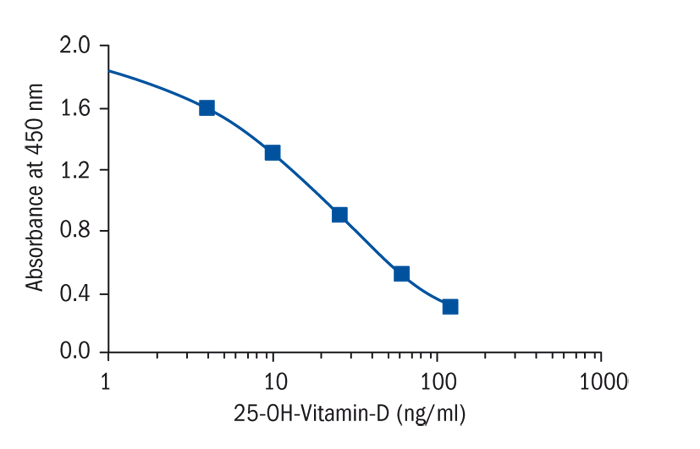Cat # changed from REA300/96 to EA300/96
Type
Competitive ELISA
Description
The new ELISA test kit is designed for the in vitro determination of 25-OH
Vitamin D in human serum or plasma samples.
Applications
Serum, Plasma-EDTA, Plasma-Heparin, Plasma-Citrate
Sample Requirements
20 µl
Shipping
On blue ice packs. Upon receipt, store the product at the temperature recommended below.
Storage/Expiration
Store the complete kit at 2–8°C. Under these conditions, the kit is stable until the expiration date (see label on the box).
Calibration Curve
Calibration Range
0 – 120 ng/ml
Limit of Detection
1.6 ng/ml
Intra-assay (Within-Run)
n = 40; CV = 5.0 %
Inter-assay (Run-to-Run)
n = 10; CV = 7.8 %
Dilution Linearity
98%
Features
- RUO
- standards 1-6: 0-120 ng/ml
- limit of detection 1.6 ng/ml
- Material of animal origin used in the preparation of the kit have been obtained from certified healthy animals but these materials should be handled as potentially infectious
Research topic
Bone and cartilage metabolism
Summary
The 25-OH Vitamin D ELISA is designed for the serological determination of the
Vitamin D concentration in the human organism. Types of Vitamin D that are
differentiated are Vitamin D2 (ergocalciferol) that is contained in plant food
(mushrooms, avocado) and Vitamin D3 (cholecalciferol) that is produced from
7-dehydrocholesterol in the skin under ultra-violet irradiation or found in animal
food or products (sea fish, egg yolk, butter) [1, 2, 3, 4]. These two forms of
Vitamin D, which are not yet biologically active, are bound by a protein called
VDBP (Vitamin D binding protein) in the bloodstream, then metabolised in the
liver and converted into 25-OH Vitamin D3 (calcidiol) and subsequently to the
biological active form 1,25(OH)2 Vitamin D3 (calcitriol) in the kidney [1]. In
contrast to other commercially available tests, the ELISA uses a newly designed
monoclonal antibody which is equally specific for both forms of the vitamin. This
is necessary because sometimes Vitamin D2 instead of D3 is used in therapy [5, 6,
7].
The new ELISA test kit is designed for the in vitro determination of 25-OH
Vitamin D in human serum or plasma samples. In the first analysis step, the
calibrators and samples are diluted with biotin-labelled 25-OH Vitamin D and
added to microplate wells coated with monoclonal anti-25-OH Vitamin D
antibodies. During the incubation an unknown amount of 25-OH Vitamin D in the
sample and a known amount of biotin-labelled 25-OH Vitamin D compete for the
antibody binding sites in the microplate wells plate. Unbound 25-OH Vitamin D is
removed by washing. For the detection of bound biotin-labelled 25-OH Vitamin D,
a second incubation is performed using peroxidase-labelled streptavidin. In a third
incubation using the peroxidase substrate tetramethylbenzidine (TMB) the bound
peroxidase promotes a colour reaction. The colour intensity is inversely
proportional to the 25-OH Vitamin D concentration.
Find documents for the lot
Example Instructions for Use (RUO)
Example Instructions for Use (RUO)

